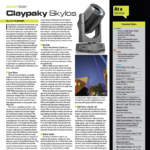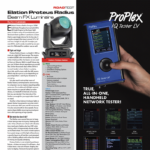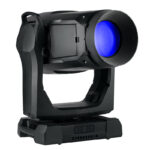MA Lighting has somehow hidden the secret that they have been working on a new console pretty much since they debuted the grandMA Series 2 line five years ago. I was amazed, not only by their ability to keep it a secret all this time, but also by how easy this console is to operate. But let’s cut to the chase and give you the facts.
The Software
The dot2 console was designed as an easy-to-use product, and it is indeed its own separate entity, with its own operating software. It fills the need for a less expensive, basic console for the user who does not require all the bells and whistles of a giant show and does not run on the same software as the Series 2 line of desks. To clarify, if you do write a show on this new console, you will be able to load the show file into the grandMA series 2 console. But you cannot load a show file from a grandMA2 into the dot2.
Both consoles share the same fixture library. However, MA has a totally separate online forum for support and users to post questions and answers in the same comfortable way the users of MA consoles have in the past: http://forum.ma-dot2.com.
The console is very intuitive and actually helps the programmer as they work through the use of view guides. Window views can change with cue strokes. For instance, as soon as I change the values of some fixtures, I hit “Store then cue” and a screen pops up with your cue list right in front of me. This makes it simple to choose the correct cue number you wish to put the new attributes into.
Patching an MA console is now incredibly simple, as it just about talks the user through the procedure. One simply opens the patch window, types in the fixture type (no need to type in manufacturer), and the console will ask you how many, what mode to use and where you wish to patch them.
The effects engine is similar in the fact that one can choose effects from the library and manipulate the usual size, speed and phase. You can still set the high and low values on each effect. There is no EFX editor like on the Series 2, but it’s so easy I personally wouldn’t miss this for a second. The effects are stored into the cues directly, but changing the values of the lights in an effect in the next cue will immediately stomp (turn off) that effect.
The console comes premade with window views, which are easily accessed via soft keys on the right side of the screen. The user cannot write in or move around their own views.
Each fader (they are non-motorized) has two buttons one can assign their own options to. This console has a limited bunch of options, and I think this is a great idea, as this desk is meant to be one that any programmer should be able to figure out quickly and it will not intimidate the beginning user.
Besides DMX, the console can spit out Art-Net and sACN to run fixtures. It has its own dedicated protocol called dot2net that can connect to outboard nodes. It does not utilize MA net 1 or MA net 2.
 The Hardware
The Hardware
Following along with the sleek black and gold colors that distinctively relate to a MA console these days, this desk is smaller in every way than the other line. A permanently tilted portion up top contains the screens. The faders, executor buttons and programming keys are all on the bottom flat part of the desk.
Model wise, they start out with three versions. First off we have the Core. It contains six faders and 12 Executor buttons for playback of cues. Of course, there are the usual pages of cues and room for as many sequences (cues) as you would like to write. The second model is the XL-B, which is the equivalent of having a permanent wing attached to the left side of the console. This console adds another eight faders and 16 Executors to the original core package. The third is the XL-F, which has 14 faders and 28 executors.
The dot2 series offers two different wings one can choose to connect to the main console via an Ethernet port. One wing is exactly like the extra section on the XLB, with eight faders and 16 executor buttons. The other wing just contains 48 executors. The user can attach two wings to a main console. What’s really cool is that, because of the way they are connected, the user could place a wing 300 feet away from the main desk. I’m sure you can imagine several scenarios where this would be quite useful.
There is indeed a dot2 onPC version available. This is free software, and you can actually use it as an offline editor at any time. Yes, you can run a show from it; if you connect a single dot2 node (1k), you can get DMX straight out of it. But there’s a catch: you are limited to two universes (1024 channels of DMX).
The console allows the user to utilize the free dot2 3D visualizer program in the same manner as the MA2 series used MA 3D.
The back of the desk shows four XLR outputs that spit out DMX. But the console can control a total of eight. Attaching a new node will open up the other four universes to DMX outputs, or one could spit out Art-Net to a device such as the existing MA2 nodes for more outputs. There is also a port to take DMX into the console.
The desk can utilize some of the things one would expect from any high performance console, such as SMPTE, MIDI, MIDI remotes, DMX remotes and even analog remotes. One can only attach one outboard monitor. A touch screen is easily used and connected via a USB port. A regular monitor connects via an SDI port.
At a Glance
Compact and User Friendly
Less grand, perhaps, in size, functionality and price, the grandMA dot2 console nevertheless holds great promise in extending MA Lighting’s reach with a console that is designed to be more affordable than the MA2 series of desks. The dot2 is just the right size for LDs who do not need the bells and whistles associated with those consoles, and the streamlined array of functional options also makes the desk easy to master.
dot2 Console from MA Lighting
PROS
- New console dedicated to a different user. Affordable, easy to use for new programmers or seasoned veterans of any other desk. Intuitive GUI system.
CONS
- Could use 8 DMX outputs on back
MSRP:
- $14,900 (dot2 Core)
- $19,100 (dot2 XL-B and dot2 XL-F)
- $5,725 (dot2 F-wing/fader wing and dot2 B-wing/executor button wing)
- $2,275 (1K dot2 Node4)
MA Lighting also offers dot2 onPC console software and the dot2 3D visualization software solutions.



